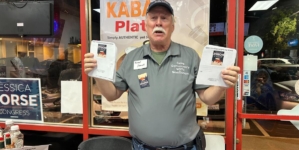-
L.A. politician Ridley-Thomas’ final campaign: to clear his name - 13 mins ago
-
Dodgers, Red Sox Talking to Same Two Free Agent Starters: Report - 20 mins ago
-
Ukraine Says Russia Struck It With New Missile; ICBM Claim Is Disputed - 25 mins ago
-
Jan. 6 defendants from California eagerly await Trump pardons - 54 mins ago
-
Americans are Shunning ‘Woke’ Words, Poll Suggests - 55 mins ago
-
Don’t Do Trump’s Work for Him on Mass Deportations - about 1 hour ago
-
Mia Khalifa’s Response to Dating Rumor Goes Viral - 2 hours ago
-
These tenants want to own their buildings. L.A. is collecting millions to help - 2 hours ago
-
International Criminal Court Issues Arrest Warrants for Netanyahu and Gallant - 2 hours ago
-
Snorkeler Channels Steve Irwin in Dream Encounter With Ocean Creatures - 2 hours ago
Column: Voters sent clear message to Newsom, Democrats: We’re fed up
SACRAMENTO — The state Legislature will convene a new two-year session on Dec. 2, and hopefully lawmakers have been reading the messages California voters sent them on election day.
The messages were straightforward and concise, although many elected officials who inhabit Sacramento’s political cocoon tend to be tone-deaf to voices that don’t emanate from large campaign donors and special interests. Most lawmakers tend to all sing the same tune in their guarded echo chamber, ignoring different sounding appeals from the public.
I’m referring mainly to liberal Democrats because they run the place and decide policy. But minority Republicans basically function the same way. There’s not a lot of individual thought by legislators — at least that they openly express — in this era of extreme polarization.
One message from California voters couldn’t have been more clear: They’re fed up with toothpaste and bandages being locked up behind glass doors on store shelves as shopkeepers try to protect their merchandise from petty thieves. Voters shouted that they want the thieves locked up, not the aftershave.
That was heard with their landslide approval of Proposition 36, which will increase punishment for repeated theft and hard drug offenses, including deadly fentanyl.
It passed by more than 2-to-1 and carried every county, including usually liberal San Francisco.
Sponsored by the California District Attorneys Assn. and bankrolled by big box retailers, the measure partially rolls back the sentence-softening Proposition 47 that voters approved overwhelmingly 10 years ago.
Alarmed progressives view Proposition 36 as reversing the movement toward criminal justice reform. But that’s not entirely true. It doesn’t mean voters are OK with police misconduct. That wasn’t on the ballot. It just means they want repetitive shoplifters and smash-and-grabbers locked away.
Gov. Gavin Newsom and the Democratic-controlled Legislature fought Proposition 36 hard — that is, until preelection polls showed it winning big. Then the governor and libs pretty much clammed up.
But many moderate Democrats — and mayors in San Diego, San Jose and San Francisco — strongly supported the measure.
Marty Wilson, chief political strategist for the California Chamber of Commerce, says Proposition 36 was prominently touted by all the candidates his organization helped, including in one heavily Democratic Los Angeles district.
Newsom and the Legislature tried to undermine Proposition 36 by enacting an alternative package of 13 anti-crime bills. But those measures didn’t really toughen sentences and voters ignored them.
The governor and the proposition’s opponents argued that crime actually was declining in California. Voters didn’t buy it.
“People don’t want to be told that crime rates are low when razor blades and hair spray have to be locked up,” Republican strategist Rob Stutzman says.
Democratic consultant Steve Maviglio says, “The election was a real slap in the face to the governor and Legislature — telling them that they are completely out of touch with the voters regarding crime.”
“It wasn’t about right or left,” says longtime Democratic consultant David Townsend. “It was a ‘duh’ moment. If you go in and steal, you should go to jail.”
Proposition 36’s lesson for policymakers: Stop easing up on criminals and start holding them more accountable.
That ballot initiative was just one part of the get-tough-on-crime message.
Los Angeles County voters booted progressive Dist. Atty. George Gascón. His victorious opponent, former federal prosecutor Nathan Hochman, attacked Gascón as a crime-fighting wimp. Gascón was a main promoter of Proposition 47 in 2014.
In liberal Alameda County, voters overwhelmingly recalled progressive Dist. Atty. Pamela Price amid anger over crime and homelessness.
“They were progressive D.A.s who really should have been public defenders and not D.A.s,” says Townsend, who advises moderate Democratic candidates.
Also part of the criminal accountability message was the voters’ rejection of Proposition 6, which would have banned prisons from forcing inmates to work. The goal made sense: Prisoners are sentenced to time behind bars, not forced labor.
But sponsors stretched the English language when they pitched it as ending the last vestiges of “slavery.” That didn’t sell.
The measure’s backers “were saying, ‘This forces prisoners to work.’ And voters were saying, ‘What’s wrong with that?’ ” Maviglio says.
Yet another election message was that voters don’t want politicians reaching further into their pockets for tax money.
They rejected Proposition 5, which would have reduced from two-thirds to 55% the vote needed to pass local bonds for affordable housing and public infrastructure.
Lowering the vote requirement was fine with me. One-third of voters shouldn’t decide matters for two-thirds. But most voters apparently understood that Proposition 5 would lead to passage of more local bonds — and that would bump up their property taxes to pay off the borrowing.
Voters also adamantly rejected Proposition 33 to boost local governments’ power to control rents — meaning what owners of rentals could charge tenants. That was considered too much government muscle.
California voters thus turned toward the center and away from Sacramento’s far left.
But they didn’t venture over to the right. They still approved two large $10-billion bond issues for school facilities and climate-related projects, including wildfire prevention.
California isn’t about to go Republican, or even return to purple. But if Democratic politicians don’t learn from this election, their supermajority dominance in Sacramento could start eroding.
“The message is very clear,” says Brian Brennan, executive director of the 21st Century Alliance, a Silicon Valley-based organization that pushes for the election of pragmatic problem solvers.
“Most California voters aren’t ideological. They don’t want rhetoric. They want governments to deliver outcomes. Move the needle.”
So listen up, legislators. And especially you, governor.
Source link



















